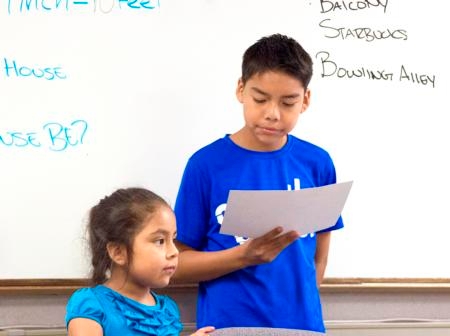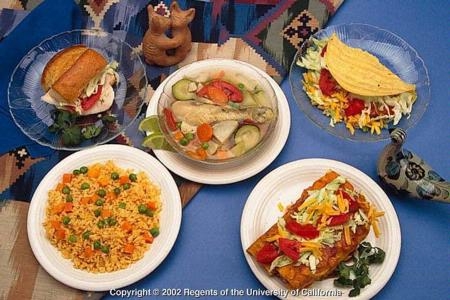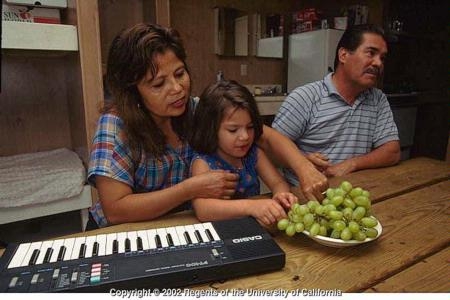
Posts Tagged: Latino
4-H Youth Development team wins national diversity award
UC 4-H Youth Development advisors Dorina Espinoza, Russell Hill, Fe Moncloa and Keith Nathaniel and 4-H associate director Shannon Horrillo have won the National Extension Diversity Award for systematically enhancing the intercultural competency of 4-H personnel and others in California. The National Extension Diversity Award was presented Sunday, Nov. 13, at the 129th Association of Public and Land-grant Universities Annual Meeting in Austin, Texas.
The award, given by USDA National Institute of Food and Agriculture (NIFA), Cooperative Extension System and the APLU, honors the team for developing and institutionalizing a professional development strategy to increase staff and academics' intercultural competence.
To support the development and well-being of California's culturally and ethnically diverse youth population, research indicates that building intercultural competence among youth development professionals is critical.

“We have been making changes to our programs to remove barriers and make 4-H more accessible. We are also testing new delivery models to expand 4-H's reach, particularly among Latino youth and families,” Horrillo said.
“This effort has been extremely successful and we are seeing the benefits in our membership,” said Horrillo. “The program's growth over the last year was significant, with a 16 percent increase in youth participation and a nearly 42 percent increase in Latino youth participation.”
“We asked Latino parents how we can help,” said Lupita Fabregas, assistant director for 4-H Diversity and Expansion. “Working parents suggested after school programs so they don't have to drive their kids to a different location.”
Through a pilot initiative in seven counties – Riverside, Orange, Kern, Santa Barbara, Monterey, Merced and Sonoma counties – UC ANR's 4-H Youth Development Program now offers in-school, after school and special interest clubs that explore subjects such as robotics. Children can join clubs that focus on projects for four to six weeks, rather than 4-H's year-long commitment. Bilingual and bicultural program representatives provide materials in English for the children and Spanish for parents. Although the activities are structured differently, they aim to teach Latino children science, leadership, civic engagement and other life skills taught through the traditional program.
The team of change agents applied the professional development strategy over three years, providing 176 hours of intercultural communication feedback sessions, learning communities and regional conferences to enhance the intercultural competence of 65 California 4-H personnel.

The UC ANR 4-H Youth Development Program has also assembled an advisory committee for 4-H multicultural and community engagement that includes Latino leaders Mary Lou de Leon Siantz, a professor at the Betty Irene Moore School of Nursing at UC Davis and director of the Center for Advancing Multicultural Perspectives on Science (CAMPOS); Steven Olmos, chief schools officer for Santa Clara County Office of Education; Albert Maldonado Jr., youth program manager for The California Endowment; and Juan P. Garcia, deputy director of the California Hispanic Chambers of Commerce.
UC ANR's action plan and resulting positive change provides a model for 4-H in other states to improve professional development and expand the program's reach. A summary of California's IDI professional development activities can be found in the National 4-H Latino Youth Outreach: Best Practices Toolkit, Professional Development.
Free Irrigation Class for Landscapers in Riverside, California (one in Spanish and one in English at the same time - bring the whole crew!)
FREE!!!! FREE!!! FREE!!!!
Three Hour Irrigation/Landscape Management Class in English and in Spanish
Co-sponsored by University of California, Ewing, and CA Dept. of Pesticide Regulation
2.5 PCA/QAL/QAC Hours Available
------------------------------
Irrigation and Fertilization Management to Conserve Water
and Keep our Waterways Clean
Location: Western Municipal Water District (WMWD), 14205 Meridian Parkway, Riverside, CA 92518
Date and Time: May 22, 2014 from 2:30-5:30 pm
Space is Limited!!! Sign up today and bring the whole crew!
Register today by contacting Meredith Odom at: 951-741-0443 modom@wbaconsulting.com
(Include all attendees' names and meeting location in the subject line. Include employer name and phone number in the email please)
Simple ways to make Latino food more nutritious
In the United States, Latinos account for 15 percent of the population, more than 47 million in all, but you can’t paint their impact on U.S. culture with a broad brush – especially when it comes to food. The Latino population is culturally and ethnically diverse.
Differences between Mexico, Puerto Rico and other Latin American countries stem from 500 years of separate histories, diverse native populations and their customs prior to the arrival of Spanish explorers. In order for nutrition educators to help Latinos maintain a healthy diet, messages should be tailored specifically to the Latino population residing in the particular geographical area.
In California, more than 80 percent of the Latino population is of Mexican descent. The Mexican diet is a blend of pre-Columbian, indigenous Indian, Spanish, French, and recently, American culture. Typically, the Mexican diet is rich in complex carbohydrates, which are provided mainly by corn and corn products, usually tortillas, present at almost every meal, beans, rice and breads. The diet also contains protein from beans, eggs, fish and shellfish, and a variety of meats, mostly pork and poultry. Traditional diets also reflect the geographic regions of Mexico and the availability of local fruits, vegetables, grains and dairy products.
There are simple ways to make traditional Mexican dishes healthier. Following are seven suggestions based on the 2010 American Dietary Guidelines:
- Substitute refried beans with whole black beans or pinto beans. Serve boiled beans instead of refrying them. For flavor, add spices like laurel leaves and other traditional spices.
- For refried beans, substitute lard, butter and shortening with olive oil or vegetable oil. These oils are free of trans fats and contain unsaturated fats, which help prevent cardiovascular disease by inhibiting the buildup of cholesterol in the body.
- Bake your own chips and use whole wheat tortillas to make them crispy and flavorful. This will reduce fat and calorie content.
- Grill or bake instead of frying to reduce the amount of oil you will ingest.
- For toppings, use plain yogurt instead of sour cream. There are some yogurts with the same consistency as sour cream. Add some chipotle, green onion and black olives to give flavor and make it attractive.
- Eat guacamole. Avocado (traditionally known as aguacate or palta) is cholesterol-free and potassium-packed.
- Use more spices – like cumin, peppers, paprika, chili sauces, garlic, cilantro and parsley – instead of salt. Keep salt consumption to less than one teaspoon per day. High salt consumption is linked to increased risk of high blood pressure and kidney disease.
The use of sugar and other caloric sweeteners – such as honey and high-fructose corn syrup – should also be minimized. They contribute to an increased risk of chronic disease, such as cardiovascular diseases and diabetes. The consumption of sugary sodas is very common in the Latino community. Some changes to reduce sugar consumption include:
- Drink water instead of sodas. Add flavor to water by adding mint, parsley, cucumber or lemon slices.
- Drink more aguas frescas; use fruits like pineapple, watermelon, melon, guava, mango. Add some cinnamon for flavor and to reduce the amount of sugar.
- Children should eat cereal without added sugar. Instead they can eat hot cereal and add seasonal fruit like apples, peaches or strawberries.
- Prepare fruits as dessert. Bake apples, serve bananas sprinkled with cinnamon and walnuts, watermelon with chili and lemon, and papaya with lemon.

Examples of traditional Mexican food.
$4.8 million study fights childhood obesity in Central Valley
UC Davis professor Adela de la Torre, a national expert on Chicano and Latino health issues, received a five-year, $4.8 million federal grant to discover the best ways to help Mexican-heritage children in California maintain healthy weights.
The study, called "Niños Sanos, Familia Sana" (Healthy Children, Healthy Family), will take place in the Central Valley towns of Firebaugh and San Joaquin.
“More than four in every 10 children born to parents of Mexican heritage are overweight or obese, and therefore at greater risk of early diabetes, high blood pressure and heart disease,” said de la Torre. “We are fortunate that we have received unprecedented support to tackle this issue from community members, so that we can build a healthier environment in Firebaugh and San Joaquin.
“We hope that this is the beginning of a series of long-term, collaborative projects to tackle issues of importance raised by our community advisory board.”
In the UC Davis "Niños Sanos, Familia Sana" study, 400 Firebaugh children and their families will be provided with practical tools, education and incentives to help them eat healthy diets and get sufficient exercise.
The Firebaugh program activities include:
- $25 monthly in vouchers that can be used to buy fruits and vegetables at participating markets
- Family Nights that include parent education about children’s nutrition needs and physical activity
- Classroom instruction for children on nutrition and physical activity
- Two health screenings yearly to monitor body mass index, skinfold thickness and waist circumference
- A community art project with murals and posters promoting healthy eating and active living
In San Joaquin, a similar number of children will receive the health screenings. In addition, their parents will be provided workshops on topics such as “How to support your children in school” and “Strategies to help your child prepare for college.” However, the San Joaquin group will not receive the more intensive intervention. (After both towns had agreed to take part in the study, a random card-draw determined that Firebaugh would be the intervention group and San Joaquin would be the control group.) At the study’s end, UC Davis researchers will analyze the results to see which strategies worked best.
“This intervention study will be one of the first of its kind in the nation for Latino children between the ages of 3 and 8 and, hopefully, will help us target what really works in sustaining healthy eating and exercise for Latino families with young children,” said de la Torre.
Lucia Kaiser, a Cooperative Extension specialist in the UC Davis nutrition department and a co-investigator on the "Niños Sanos, Familia Sana" study, said, “This project is an exciting opportunity to pull a multidisciplinary University of California team of social scientists and other professionals to work in partnership with an underserved community to address a pressing health problem -- childhood obesity.”

UC Davis scientists to look for best ways for Latino children to maintain healthy weights.
Changing East LA one corner store at a time
In October 2009, UC Cooperative Extension in Los Angeles County was awarded a grant from the “UCLA REACH U.S. Legacy Project” to implement the “East Los Angeles Nutrition Project” - an exciting new initiative that aims to increase the availability of fresh fruits and vegetables for residents of East LA through healthy corner store and restaurant “makeovers.” East LA was chosen for this project not only because Cooperative Extension is located in this area and has strong ties to the community, but also because residents have poor access to healthy, affordable food. This predominantly low-income, Latino community has many fast food restaurants, few grocery stores with high quality fruits and vegetables, and one of the highest rates of childhood obesity in the county.
Through the eyes of the community
A team of dedicated East LA residents have met monthly at the UCCE office to discuss what they would like to see in terms of healthy food offerings in their neighborhood. In order to make their voices heard, these residents were given cameras and asked to go out and document their food environment. The photographs and narrative descriptions were presented at a community event, which was hosted by Cooperative Extension. Local residents, business owners, community agencies, youth and representatives of elected officials attended the event. The photos were a depiction of the problems facing this community. Everyone agreed that something needs to be done to improve the availability of healthy, affordable food for local residents and to address nutrition-related health problems facing many families in East LA.
Putting it into action
On Saturday, May 8, Cooperative Extension staff and members of the “East Los Angeles Nutrition Project” met at Super Chavez, a locally owned corner store, to conduct recipe demonstrations and free food tastings for the public. The purpose was to draw attention to the high-quality, low-cost produce available in the store. The event was fun and well-received by the community. Cooperative Extension plans to hold similar events at food establishments throughout the East LA area. Staff members hope to provide technical assistance, nutrition expertise and free advertising opportunities to businesses who participate in this project – all in an attempt to bring lasting change to a community in need of a healthy makeover one corner store and restaurant at a time!
For more information about this project, please contact Los Angeles County Nutrition, Family & Consumer Sciences advisor Brenda Roche at bkroche@ucdavis.edu, (323) 260-3299.

Super Chavez food demo

